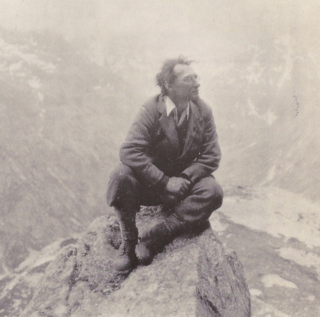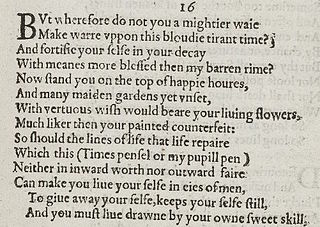Related Research Articles

Sir William Empson was an English literary critic and poet, widely influential for his practice of closely reading literary works, a practice fundamental to New Criticism. His best-known work is his first, Seven Types of Ambiguity, published in 1930.

A figure of speech or rhetorical figure is a word or phrase that intentionally deviates from straightforward language use or literal meaning to produce a rhetorical or intensified effect. In the distinction between literal and figurative language, figures of speech constitute the latter. Figures of speech are traditionally classified into schemes, which vary the ordinary sequence of words, and tropes, where words carry a meaning other than what they ordinarily signify.

Laura Riding Jackson, best known as Laura Riding, was an American poet, critic, novelist, essayist and short story writer.
Allusion, or alluding, is a figure of speech that makes a reference to someone or something by name without explaining how it relates to the given context, so that the audience must realize the connection in their own minds. When a connection is directly and explicitly explained, it is instead often simply termed a reference. In the arts, a literary allusion puts the alluded text in a new context under which it assumes new meanings and denotations. Literary allusion is closely related to parody and pastiche, which are also "text-linking" literary devices.
Stylistics, a branch of applied linguistics, is the study and interpretation of texts of all types, but particularly literary texts, and spoken language with regard to their linguistic and tonal style, where style is the particular variety of language used by different individuals in different situations and settings. For example, the vernacular, or everyday language, may be used among casual friends, whereas more formal language, with respect to grammar, pronunciation or accent, and lexicon or choice of words, is often used in a cover letter and résumé and while speaking during a job interview.
In literary criticism, close reading is the careful, sustained interpretation of a brief passage of a text. A close reading emphasizes the single and the particular over the general, via close attention to individual words, the syntax, the order in which the sentences unfold ideas, as well as formal structures.
New Criticism was a formalist movement in literary theory that dominated American literary criticism in the middle decades of the 20th century. It emphasized close reading, particularly of poetry, to discover how a work of literature functioned as a self-contained, self-referential aesthetic object. The movement derived its name from John Crowe Ransom's 1941 book The New Criticism.

Ivor Armstrong Richards CH, known as I. A. Richards, was an English educator, literary critic, poet, and rhetorician. His work contributed to the foundations of New Criticism, a formalist movement in literary theory which emphasized the close reading of a literary text, especially poetry, in an effort to discover how a work of literature functions as a self-contained and self-referential æsthetic object.
William Kurtz Wimsatt Jr. was an American professor of English, literary theorist, and critic. Wimsatt is often associated with the concept of the intentional fallacy, which he developed with Monroe Beardsley in order to question the importance of an author's intentions for the creation of a work of art.

Cleanth Brooks was an American literary critic and professor. He is best known for his contributions to New Criticism in the mid-20th century and for revolutionizing the teaching of poetry in American higher education. His best-known works, The Well Wrought Urn: Studies in the Structure of Poetry (1947) and Modern Poetry and the Tradition (1939), argue for the centrality of ambiguity and paradox as a way of understanding poetry. With his writing, Brooks helped to formulate formalist criticism, emphasizing "the interior life of a poem" and codifying the principles of close reading.
In literary theory and aesthetics, authorial intent refers to an author's intent as it is encoded in their work. Authorial intentionalism is the hermeneutical view that an author's intentions should constrain the ways in which a text is properly interpreted. Opponents, who dispute its hermeneutical importance, have labelled this position the intentional fallacy and count it among the informal fallacies.
Moses ben Jacob ibn Ezra, known as Ha-Sallaḥ was an Andalusi Jewish rabbi, philosopher, linguist, and poet. He was born in Granada about 1055–1060, and died after 1138. Ibn Ezra is considered to have had great influence in the Arabic literary world. He is considered one of Spain's greatest poets and was considered ahead of his time in his theories on the nature of poetry. One of the more revolutionary aspects of Ibn Ezra's poetry that has been debated is his definition of poetry as metaphor and how his poetry illuminates Aristotle's early ideas. The importance of ibn Ezra's philosophical works was minor compared to his poetry. They address his concept of the relationship between God and man.
Balachandra Rajan was an Indian diplomat and a scholar of poetry and poetics.

Sonnet 16 is one of 154 sonnets written by the English playwright and poet William Shakespeare. It is among those sonnets referred to as the procreation sonnets, within the Fair Youth sequence.

William Shakespeare's Sonnet 35 is part of the Fair Youth sequence, commonly agreed to be addressed to a young man; more narrowly, it is part of a sequence running from 33 to 42, in which the speaker considers a sin committed against him by the young man, which the speaker struggles to forgive.

Understanding Poetry was an American college textbook and poetry anthology by Cleanth Brooks and Robert Penn Warren, first published in 1938. The book influenced New Criticism and went through its fourth edition in 1976.
Sonnet 101 is one of 154 sonnets written by the English playwright and poet William Shakespeare. It is a member of the Fair Youth sequence, in which the poet expresses his love towards a young man. The three other internal sequences include the procreation sonnets (1–17), the Rival Poet sequence (78–86) and the Dark Lady sequence (127–154). While the exact date of composition of Sonnet 101 is unknown, scholars generally agree that the group of Sonnets 61–103 was written mainly in the first half of the 1590s and was not revised before being published with the complete sequence of sonnets in the 1609 Quarto.

The Well Wrought Urn: Studies in the Structure of Poetry is a 1947 collection of essays by Cleanth Brooks. It is considered a seminal text in the New Critical school of literary criticism. The title contains an allusion to the fourth stanza of John Donne's poem, "The Canonization", which is the primary subject of the first chapter of the book.
In literature, the paradox is an anomalous juxtaposition of incongruous ideas for the sake of striking exposition or unexpected insight. It functions as a method of literary composition and analysis that involves examining apparently contradictory statements and drawing conclusions either to reconcile them or to explain their presence.
Cambridge criticism is a school in literary theory that focuses on the close examination of the literary text and the link between literature and social issues. Members of this group exerted influence on English literary studies during the 1920s. It has been characterized as Puritan due to its reluctance to consider literature simply as a matter for enjoyment.
References
- ↑ "Sir William Empson", Encyclopædia Britannica 2003 DVD Edition.
- ↑ "The Sacrifice", Chapter VII from "Seven Types of Ambiguity", William Empson. "Type_Document_Title_here". Archived from the original on October 27, 2009. Retrieved 2007-04-11.
{{cite web}}: CS1 maint: bot: original URL status unknown (link)